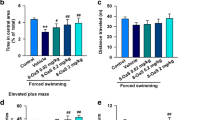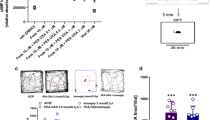Abstract
Pain and anxiety have a complex relationship and pain is known to share neurobiological pathways and neurotransmitters with anxiety. Top-down modulatory pathways of pain have been shown to originate from cortical and subcortical regions, including the dorsolateral prefrontal cortex. In this study, a novel docosahexaenoic acid (DHA)-containing nutraceutical, Souvenaid, was administered to mice with infraorbital nerve ligation-induced neuropathic pain and behavioral responses recorded. Infraorbital nerve ligation resulted in increased face wash strokes of the face upon von Frey hair stimulation, indicating increased nociception. Part of this response involves general pain sensitization that is dependent on the CNS, since increased nociception was also found in the paws during the hot plate test. Mice receiving oral gavage of Souvenaid, a nutraceutical containing DHA; choline; and other cell membrane components, showed significantly reduced pain sensitization. The mechanism of Souvenaid’s activity involves supraspinal antinociception, originating in the prefrontal cortex, since inhibition of the DHA-metabolizing enzyme 15-lipoxygenase (Alox15) in the prefrontal cortex attenuated the antinociceptive effect of Souvenaid. Alox15 inhibition also modulated anxiety behavior associated with pain after infraorbital nerve ligation. The effects of Souvenaid components and Alox15 on reducing central sensitization of pain may be due to strengthening of a known supraspinal antinociceptive pathway from the prefrontal cortex to the periaqueductal gray. Together, results indicate the importance of the prefrontal cortex and DHA/Alox15 in central antinociceptive pathways and suggest that Souvenaid may be a novel therapeutic for neuropathic pain.








Similar content being viewed by others
Abbreviations
- AA:
-
Arachidonic acid
- AD:
-
Alzheimer ’s disease
- Alox15:
-
Arachidonate 15-lipoxygenase
- Alox15B:
-
Epidermis type 15-lipoxygenase
- CNS:
-
Central nervous system
- DHA:
-
Docosahexanoic acid
- DMSO:
-
Dimethyl sulfoxide
- fMRI:
-
Functional magnetic resonance imaging
- FST:
-
Forced swim test
- HFS:
-
High frequency stimulation
- ION:
-
Infraorbital nerve
- IONL:
-
Infraorbital nerve ligation
- IL-1β:
-
Interleukin-1 beta
- iPLA2 :
-
Calcium independent Phospholipase A2
- NPD1:
-
Neuroprotectin D1
- PAG:
-
Periaqueductal gray
- PFC:
-
Prefrontal cortex
- PLA2 :
-
Phospholipase A2
- PUFA:
-
Polyunsaturated Fatty Acid
- PVDF:
-
Polyvinylidene difluoride
- RvD1:
-
Resolvin D1
- RvD2:
-
Resolvin D2
- SDS-PAGE:
-
Sodium dodecyl sulfate polyacrylamide gel
- TBST:
-
Tris buffered saline–Tween
References
Koltzenburg M, Scadding J (2001) Neuropathic pain. Curr Opin Neurol 14(5):641–647
Schaible H-G (2006) Peripheral and central mechanisms of pain generation. In: Analgesia. Springer, pp 3–28
Woolf CJ (2011) Central sensitization: implications for the diagnosis and treatment of pain. Pain 152(3 Suppl):S2–15. doi:10.1016/j.pain.2010.09.030
Ji RR, Kohno T, Moore KA, Woolf CJ (2003) Central sensitization and LTP: do pain and memory share similar mechanisms? Trends Neurosci 26(12):696–705. doi:10.1016/j.tins.2003.09.017
Legrain V, Iannetti GD, Plaghki L, Mouraux A (2011) The pain matrix reloaded: a salience detection system for the body. Prog Neurobiol 93(1):111–124. doi:10.1016/j.pneurobio.2010.10.005
Lorenz J, Minoshima S, Casey KL (2003) Keeping pain out of mind: the role of the dorsolateral prefrontal cortex in pain modulation. Brain: A Journal of Neurology 126(Pt 5):1079–1091
Bingel U, Tracey I (2008) Imaging CNS modulation of pain in humans. Physiology 23:371–380. doi:10.1152/physiol.00024.2008
Bingel U, Schoell E, Buchel C (2007) Imaging pain modulation in health and disease. Curr Opin Neurol 20(4):424–431. doi:10.1097/WCO.0b013e328259c34d
Almeida TF, Roizenblatt S, Tufik S (2004) Afferent pain pathways: a neuroanatomical review. Brain Res 1000(1–2):40–56. doi:10.1016/j.brainres.2003.10.073
Zubieta JK, Bueller JA, Jackson LR, Scott DJ, Xu Y, Koeppe RA, Nichols TE, Stohler CS (2005) Placebo effects mediated by endogenous opioid activity on mu-opioid receptors. The Journal of neuroscience : the official journal of the Society for Neuroscience 25(34):7754–7762. doi:10.1523/JNEUROSCI.0439-05.2005
Valet M, Sprenger T, Boecker H, Willoch F, Rummeny E, Conrad B, Erhard P, Tolle TR (2004) Distraction modulates connectivity of the cingulo-frontal cortex and the midbrain during pain—an fMRI analysis. Pain 109(3):399–408. doi:10.1016/j.pain.2004.02.033
Delgado PL (2004) Common pathways of depression and pain. The Journal of clinical psychiatry 65(Suppl 12):16–19
Robinson MJ, Edwards SE, Iyengar S, Bymaster F, Clark M, Katon W (2009) Depression and pain. Front Biosci (Landmark Ed) 14:5031–5051
Katon W, Lin EH, Kroenke K (2007) The association of depression and anxiety with medical symptom burden in patients with chronic medical illness. Gen Hosp Psychiatry 29(2):147–155. doi:10.1016/j.genhosppsych.2006.11.005
McCracken LM, Spertus IL, Janeck AS, Sinclair D, Wetzel FT (1999) Behavioral dimensions of adjustment in persons with chronic pain: pain-related anxiety and acceptance. Pain 80(1–2):283–289
Fujita S, Ikegaya Y, Nishikawa M, Nishiyama N, Matsuki N (2001) Docosahexaenoic acid improves long-term potentiation attenuated by phospholipase A(2) inhibitor in rat hippocampal slices. Br J Pharmacol 132(7):1417–1422. doi:10.1038/sj.bjp.0703970
Tokuyama S, Nakamoto K (2011) Unsaturated fatty acids and pain. Biol Pharm Bull 34(8):1174–1178
Jacka FN, Pasco JA, Williams LJ, Meyer BJ, Digger R, Berk M (2013) Dietary intake of fish and PUFA, and clinical depressive and anxiety disorders in women. Br J Nutr 109(11):2059–2066. doi:10.1017/S0007114512004102
Calder PC (2006) N-3 polyunsaturated fatty acids, inflammation, and inflammatory diseases. Am J Clin Nutr 83(6 Suppl):1505S–1519S
Goldberg RJ, Katz J (2007) A meta-analysis of the analgesic effects of omega-3 polyunsaturated fatty acid supplementation for inflammatory joint pain. Pain 129(1–2):210–223. doi:10.1016/j.pain.2007.01.020
Lee LH, Tan CH, Shui G, Wenk MR, Ong WY (2012) Role of prefrontal cortical calcium independent phospholipase A(2) in antidepressant-like effect of maprotiline. The international journal of neuropsychopharmacology / official scientific journal of the Collegium Internationale Neuropsychopharmacologicum 15(8):1087–1098. doi:10.1017/S1461145711001234
Rapoport SI, Ramadan E, Basselin M (2011) Docosahexaenoic acid (DHA) incorporation into the brain from plasma, as an in vivo biomarker of brain DHA metabolism and neurotransmission. Prostaglandins & other lipid mediators 96(1–4):109–113. doi:10.1016/j.prostaglandins.2011.06.003
Jiang WG, Watkins G, Douglas-Jones A, Mansel RE (2006) Reduction of isoforms of 15-lipoxygenase (15-LOX)-1 and 15-LOX-2 in human breast cancer. Prostaglandins Leukot Essent Fat Acids 74(4):235–245. doi:10.1016/j.plefa.2006.01.009
Sigal E, Craik CS, Highland E, Grunberger D, Costello LL, Dixon RA, Nadel JA (1988) Molecular cloning and primary structure of human 15-lipoxygenase. Biochem Biophys Res Commun 157(2):457–464
Brash AR, Boeglin WE, Chang MS (1997) Discovery of a second 15S-lipoxygenase in humans. Proc Natl Acad Sci U S A 94(12):6148–6152
Kohli P, Levy BD (2009) Resolvins and protectins: mediating solutions to inflammation. Br J Pharmacol 158(4):960–971. doi:10.1111/j.1476-5381.2009.00290.x
Serhan CN, Dalli J, Colas RA, Winkler JW, Chiang N (2015) Protectins and maresins: new pro-resolving families of mediators in acute inflammation and resolution bioactive metabolome. Biochim Biophys Acta 1851(4):397–413. doi:10.1016/j.bbalip.2014.08.006
Dobson EP, Barrow CJ, Kralovec JA, Adcock JL (2013) Controlled formation of mono- and dihydroxy-resolvins from EPA and DHA using soybean 15-lipoxygenase. J Lipid Res 54(5):1439–1447. doi:10.1194/jlr.M036186
Xu ZZ, Liu XJ, Berta T, Park CK, Lu N, Serhan CN, Ji RR (2013) Neuroprotectin/protectin D1 protects against neuropathic pain in mice after nerve trauma. Ann Neurol 74(3):490–495. doi:10.1002/ana.23928
Scheltens P, Kamphuis PJ, Verhey FR, Olde Rikkert MG, Wurtman RJ, Wilkinson D, Twisk JW, Kurz A (2010) Efficacy of a medical food in mild Alzheimer’s disease: a randomized, controlled trial. Alzheimer’s & Dementia : the Journal of the Alzheimer’s Association 6(1):1–10 e11. doi:10.1016/j.jalz.2009.10.003
Rijpma A, Meulenbroek O, van Hees AM, Sijben JW, Vellas B, Shah RC, Bennett DA, Scheltens P, Olde Rikkert MG (2015) Effects of Souvenaid on plasma micronutrient levels and fatty acid profiles in mild and mild-to-moderate Alzheimer’s disease. Alzheimers Res Ther 7(1):51. doi:10.1186/s13195-015-0134-1
Ritchie CW, Bajwa J, Coleman G, Hope K, Jones RW, Lawton M, Marven M, Passmore P (2014) Souvenaid(R): a new approach to management of early Alzheimer’s disease. J Nutr Health Aging 18(3):291–299. doi:10.1007/s12603-013-0411-2
Shah RC, Kamphuis PJ, Leurgans S, Swinkels SH, Sadowsky CH, Bongers A, Rappaport SA, Quinn JF, Wieggers RL, Scheltens P, Bennett DA (2013) The S-connect study: results from a randomized, controlled trial of Souvenaid in mild-to-moderate Alzheimer’s disease. Alzheimers Res Ther 5(6):59. doi:10.1186/alzrt224
Scheltens P, Twisk JW, Blesa R, Scarpini E, von Arnim CA, Bongers A, Harrison J, Swinkels SH, Stam CJ, de Waal H, Wurtman RJ, Wieggers RL, Vellas B, Kamphuis PJ (2012) Efficacy of Souvenaid in mild Alzheimer’s disease: results from a randomized, controlled trial. Journal of Alzheimer’s disease : JAD 31(1):225–236. doi:10.3233/JAD-2012-121189
Dominguez CA, Kouya PF, Wu WP, Hao JX, Xu XJ, Wiesenfeld-Hallin Z (2009) Sex differences in the development of localized and spread mechanical hypersensitivity in rats after injury to the infraorbital or sciatic nerves to create a model for neuropathic pain. Gender medicine 6(Suppl 2):225–234. doi:10.1016/j.genm.2009.01.003
Xu M, Aita M, Chavkin C (2008) Partial infraorbital nerve ligation as a model of trigeminal nerve injury in the mouse: behavioral, neural, and glial reactions. The journal of pain : official journal of the American Pain Society 9(11):1036–1048. doi:10.1016/j.jpain.2008.06.006
Vos BP, Strassman AM, Maciewicz RJ (1994) Behavioral evidence of trigeminal neuropathic pain following chronic constriction injury to the rat’s infraorbital nerve. The Journal of neuroscience : the official journal of the Society for Neuroscience 14(5 Pt 1):2708–2723
Bourin M, Hascoet M (2003) The mouse light/dark box test. Eur J Pharmacol 463(1–3):55–65
Porsolt RD, Bertin A, Jalfre M (1977) Behavioral despair in mice: a primary screening test for antidepressants. Archives internationales de pharmacodynamie et de therapie 229(2):327–336
Asmundson GJ, Wright KD, Stein MB (2004) Pain and PTSD symptoms in female veterans. Eur J Pain 8(4):345–350. doi:10.1016/j.ejpain.2003.10.008
Melzack R, Katz J (2004) The gate control theory: reaching for the brain. Pain: Psychological perspectives:13–34
Raphael KG, Janal MN, Nayak S, Schwartz JE, Gallagher RM (2006) Psychiatric comorbidities in a community sample of women with fibromyalgia. Pain 124(1–2):117–125. doi:10.1016/j.pain.2006.04.004
Petrovic P, Kalso E, Petersson KM, Ingvar M (2002) Placebo and opioid analgesia—imaging a shared neuronal network. Science 295(5560):1737–1740. doi:10.1126/science.1067176
Willis WD Jr (1985) Central nervous system mechanisms for pain modulation. Applied neurophysiology 48(1–6):153–165
Nakamoto K, Nishinaka T, Mankura M, Fujita-Hamabe W, Tokuyama S (2010) Antinociceptive effects of docosahexaenoic acid against various pain stimuli in mice. Biol Pharm Bull 33(6):1070–1072
Takeuchi T, Iwanaga M, Harada E (2003) Possible regulatory mechanism of DHA-induced anti-stress reaction in rats. Brain Res 964(1):136–143
Pardini M, Serrati C, Guida S, Mattei C, Abate L, Massucco D, Sassos D, Amore M, Krueger F, Cocito L, Emberti Gialloreti L (2015) Souvenaid reduces behavioral deficits and improves social cognition skills in frontotemporal dementia: a proof-of-concept study. Neurodegener Dis 15(1):58–62. doi:10.1159/000369811
Acknowledgments
This work was supported by grants from the National Medical Research Council and the National University Health System of Singapore.
Author information
Authors and Affiliations
Corresponding author
Ethics declarations
Conflict of Interest
The authors declare that they have no conflict of interest.
Rights and permissions
About this article
Cite this article
Shalini, SM., Herr, D.R. & Ong, WY. The Analgesic and Anxiolytic Effect of Souvenaid, a Novel Nutraceutical, Is Mediated by Alox15 Activity in the Prefrontal Cortex. Mol Neurobiol 54, 6032–6045 (2017). https://doi.org/10.1007/s12035-016-0138-2
Received:
Accepted:
Published:
Issue Date:
DOI: https://doi.org/10.1007/s12035-016-0138-2




